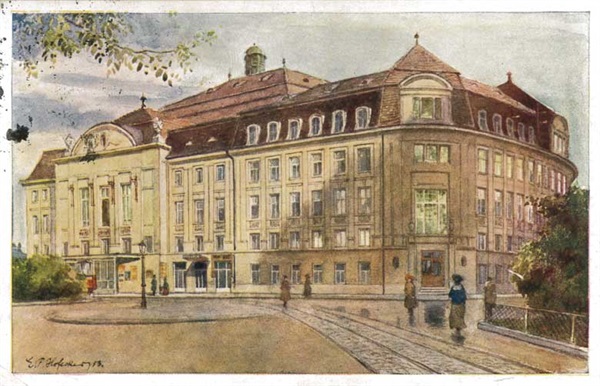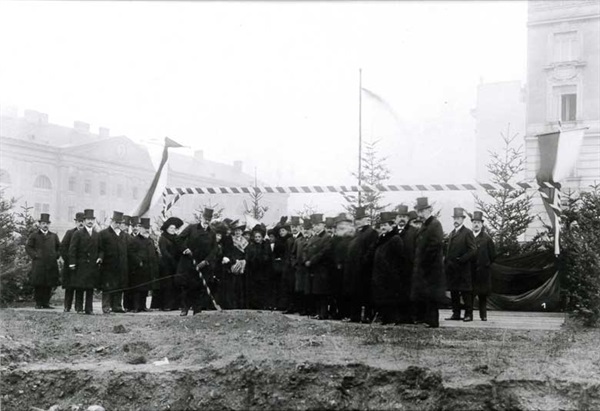
Postkarte nach einem Aquarell von E. F. Hofecker, 1913

Wiener Konzerthaus, Erster Spatenstich, 9. Dezember 1911
Historical
The Wiener Konzerthaus is one of the largest and most artistically progressive institutions in international musical life. During the course of a season, which extends from September to June, some 750 wide-ranging events take place and more than 600,000 visitors can listen to around 2,500 different compositions. With this comprehensive and varied selection, the Wiener Konzerthaus – together with the Vienna State Opera House and the Musikverein – is central to Vienna’s reputation as one of the world’s leading music capitals.
From its earliest days, the Wiener Konzerthaus has held the highest cultural aims and artistic mission: »To act as a venue for the cultivation of fine music, as a meeting point for artistic endeavour, as a home for music and a cultural centre for Vienna«. It was in this spirit that the Konzerthaus was inaugurated on 19 October 1913 with a festive concert attended by Emperor Francis Joseph I. To mark the occasion, Richard Strauss wrote the »Festliches Präludium op. 61«, which was followed by Beethoven’s Ninth Symphony. This programme combination, comprising a contemporary work and a masterpiece from the past, served as a model for the Wiener Konzerthaus’s future direction: today, too, an awareness of tradition and the joys of innovation form the main pillars of the Konzerthaus’s artistic identity.
The Wiener Konzerthaus has always been open to new artistic influences, as well as endeavouring to satisfy the demands of tradition. With the passage of time, the nature and range of the events held in the Wiener Konzerthaus since 1913 have expanded, reflecting the changes in cultural and social life of the times.
The social upheavals and financial crises of the inter-war period left an indelible imprint on the Konzerthaus’s artistic output, generating a wide range of cultural activities, which were pioneering in their time. In addition to its consistent attention to classical repertoire, the programmes of the Twenties and Thirties featured major premières, jazz and popular concerts, readings by famous writers, lectures on spiritualism, modern dance events, symposia, conferences, and world fencing and boxing championships.
For the Wiener Konzerthaus, the years between 1938 and 1945 were a period of cultural impoverishment. The Wiener Konzerthausgesellschaft, which continued to operate as an independent institution during the Nazi period, put itself at the disposal of the criminal regime and in doing so effectively robbed itself of its central values. By continuing to stage classical music concerts, they tried, on the face of it, to convey the impression that a dignified high culture was being nurtured and upheld (albeit with a drastically reduced repertoire), but the Great Hall was primarily used as a popular venue for the »Colourful Evenings« of the »Kraft durch Freude (KdF)« or Strength Through Joy movement: A mixed and uncomplicated programme comprising of light music, cabaret and artistic numbers was intended to distract the working population from the increasing horrors of everyday life during wartime.
After World War II, the Konzerthaus played an important role in reviving and renewing Austrian musical life and, in the following years, became the leading organiser of contemporary music in Austria and the most sought-after stage for international jazz in Vienna. The series of events created by the Konzerthaus left a decisive imprint on Viennese cultural life. Since then, early music, jazz and new music have featured prominently within the Konzerthaus's programme, contributing to a celebration of classical music in its entire range.
The unique atmosphere of the Wiener Konzerthaus not only attract artists from the international music scene, but also forms the setting for numerous other social events such as balls, conferences, dinners, company presentations and festivities. The Konzerthaus's experience of hosting a wide variety of events extends back to the Twenties. With its most recent major renovation (1998–2001), the historic building is now well-equipped to meet the challenges of the third millennium.
Executive Chairmen after 1945
Egon Seefehlner (1946–1961)
Peter Weiser (1961–1977)
Hans Landesmann (1978–1984)
Alexander Pereira (1984–1991)
Karsten Witt (1991–1996)
Christoph Lieben-Seutter (1996–2007)
Bernhard Kerres (2007–2013)
Matthias Naske (since 2013)